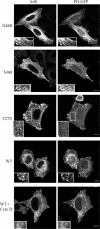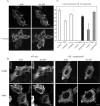An effector domain mutant of Arf6 implicates phospholipase D in endosomal membrane recycling
- PMID: 16280360
- PMCID: PMC1345670
- DOI: 10.1091/mbc.e05-06-0523
An effector domain mutant of Arf6 implicates phospholipase D in endosomal membrane recycling
Abstract
In this study, we investigated the role of phospholipase D (PLD) in mediating Arf6 function in cells. Expression of Arf6 mutants that are defective in activating PLD, Arf6N48R and Arf6N48I, inhibited membrane recycling to the plasma membrane (PM), resulting in an accumulation of tubular endosomal membranes. Additionally, unlike wild-type Arf6, neither Arf6 mutant could generate protrusions or recruit the Arf6 GTPase activating protein (GAP) ACAP1 onto the endosome in the presence of aluminum fluoride. Remarkably, all of these phenotypes, including accumulated tubular endosomes, blocked recycling, and failure to make protrusions and recruit ACAP effectively, could be recreated in either untransfected cells or cells expressing wild-type Arf6 by treatment with 1-butanol to inhibit the formation of phosphatidic acid (PA), the product of PLD. Moreover, most of the defects present in cells expressing Arf6N48R or N48I could be reversed by treatment with agents expected to elevate PA levels in cells. Together, these observations provide compelling evidence that Arf6 stimulation of PLD is required for endosomal membrane recycling and GAP recruitment.
Figures







Similar articles
-
ACAPs are arf6 GTPase-activating proteins that function in the cell periphery.J Cell Biol. 2000 Oct 30;151(3):627-38. doi: 10.1083/jcb.151.3.627. J Cell Biol. 2000. PMID: 11062263 Free PMC article.
-
Localization and regulation of phospholipase D2 by ARF6.J Cell Biochem. 2005 May 1;95(1):149-64. doi: 10.1002/jcb.20351. J Cell Biochem. 2005. PMID: 15759270
-
Aluminum fluoride stimulates surface protrusions in cells overexpressing the ARF6 GTPase.J Cell Biol. 1996 Aug;134(4):935-47. doi: 10.1083/jcb.134.4.935. J Cell Biol. 1996. PMID: 8769418 Free PMC article.
-
ADP-ribosylation factor GTPases in signal transduction and membrane traffic: independent functions?Biochem Soc Trans. 1999 Aug;27(4):642-7. doi: 10.1042/bst0270642. Biochem Soc Trans. 1999. PMID: 10917658 Review. No abstract available.
-
Phospholipase D in endocytosis and endosomal recycling pathways.Biochim Biophys Acta. 2009 Sep;1791(9):845-9. doi: 10.1016/j.bbalip.2009.05.011. Epub 2009 Jun 18. Biochim Biophys Acta. 2009. PMID: 19540357 Free PMC article. Review.
Cited by
-
CED-6/GULP and components of the clathrin-mediated endocytosis machinery act redundantly to correctly display CED-1 on the cell membrane in Caenorhabditis elegans.G3 (Bethesda). 2024 Jul 8;14(7):jkae088. doi: 10.1093/g3journal/jkae088. G3 (Bethesda). 2024. PMID: 38696649 Free PMC article.
-
The Arf family GTPases: Regulation of vesicle biogenesis and beyond.Bioessays. 2023 Jun;45(6):e2200214. doi: 10.1002/bies.202200214. Epub 2023 Mar 30. Bioessays. 2023. PMID: 36998106 Free PMC article. Review.
-
Arf6 promotes autophagosome formation via effects on phosphatidylinositol 4,5-bisphosphate and phospholipase D.J Cell Biol. 2012 Feb 20;196(4):483-96. doi: 10.1083/jcb.201110114. J Cell Biol. 2012. PMID: 22351926 Free PMC article.
-
The role of MHC class I recycling and Arf6 in cross-presentation by murine dendritic cells.Life Sci Alliance. 2019 Nov 18;2(6):e201900464. doi: 10.26508/lsa.201900464. Print 2019 Dec. Life Sci Alliance. 2019. PMID: 31740564 Free PMC article.
-
Binding of PLD2-Generated Phosphatidic Acid to KIF5B Promotes MT1-MMP Surface Trafficking and Lung Metastasis of Mouse Breast Cancer Cells.Dev Cell. 2017 Oct 23;43(2):186-197.e7. doi: 10.1016/j.devcel.2017.09.012. Epub 2017 Oct 12. Dev Cell. 2017. PMID: 29033361 Free PMC article.
References
-
- Brown, F. D., Thompson, N., Saqib, K. M., Clark, J. M., Powner, D., Thompson, N. T., Solari, R., and Wakelam, M. J. (1998). Phospholipase D1 localises to secretory granules and lysosomes and is plasma-membrane translocated on cellular stimulation. Curr. Biol. 8, 835-838. - PubMed
-
- Brown, H. A., Gutowski, S., Moomaw, C. R., Slaughter, C., and Sternweis, P. C. (1993). ADP-ribosylation factor, a small GTP-dependent regulatory protein, stimulates phospholipase D activity. Cell 75, 1137-1144. - PubMed
-
- Caumont, A. S., Galas, M. C., Vitale, N., Aunis, D., and Bader, M. F. (1998). Regulated exocytosis in chromaffin cells. Translocation of ARF6 stimulates a plasma membrane-associated phospholipase D. J. Biol. Chem. 273, 1373-1379. - PubMed
MeSH terms
Substances
Grants and funding
LinkOut - more resources
Full Text Sources
Other Literature Sources
Miscellaneous

